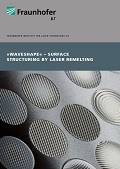Surface structuring by laser remelting is based on a remelting process that uses continuous laser radiation and that simultaneously modulates the laser power. This modulation varies the melt pool volume. When the laser power is increased, the volume of the melt pool enlarges since the melting rate increases. This leads to a bulging of the melt pool. The solidification follows the curved surface of the melt pool, resulting in an elevation. If the laser power is reduced, the mechanisms work in opposite directions and a depression is formed. The elevations protrude above the level of the initial surface, while the depressions are below this level. The neutral mass balance clearly distinguishes the process from other ablative (subtractive) and constructive (additive) surface structuring processes.
In contrast to surface structuring by laser ablation, the WaveShape process already smooths the structures simultaneously after laser remelting since they are created from a continuous melt, as in laser polishing. This eliminates the need for additional post-processing.
So far the process has been used for metallic materials. Defined and reproducible structures are best produced on homogeneous materials. The remelting depth is in the range between 10 and 100 μm. Fiber or disk lasers are usually used as laser beam sources, as they are common in industrial laser material processing. Since a melt is generated, the process is always accompanied by heat input into the component. The formation of structures through multiple remelting is relatively complex. Therefore, the process parameters have to be adapted individually to the material and target structure.

 Fraunhofer Institute for Laser Technology ILT
Fraunhofer Institute for Laser Technology ILT